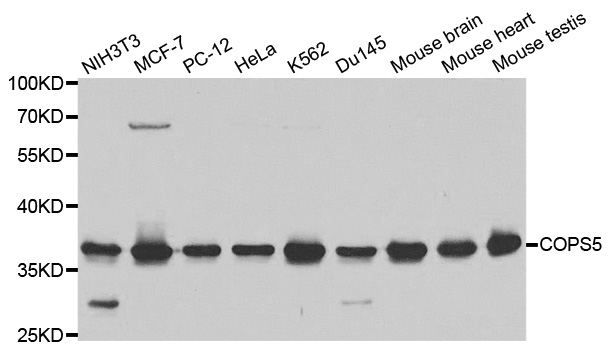JAB1 (COPS5) Rabbit Polyclonal Antibody
USD 436.00
USD 200.00
USD 867.00
Specifications
| Product Data | |
| Applications | WB |
| Recommended Dilution | WB 1:500 - 1:2000 |
| Reactivities | Human, Mouse, Rat |
| Host | Rabbit |
| Isotype | IgG |
| Clonality | Polyclonal |
| Immunogen | Recombinant protein of human COPS5 |
| Formulation | Store at -20°C (regular) and -80°C (long term). Avoid freeze / thaw cycles. Buffer: PBS with 0.02% sodium azide, 50% glycerol, pH7.3. |
| Concentration | lot specific |
| Purification | Affinity purification |
| Conjugation | Unconjugated |
| Storage | Store at -20°C as received. |
| Stability | Stable for 12 months from date of receipt. |
| Predicted Protein Size | 37 kDa |
| Gene Name | COP9 signalosome subunit 5 |
| Database Link | |
| Background | The COP9 Signalosome (CSN) is a ubiquitously expressed multiprotein complex that is involved in a vast array of cellular and developmental processes, which is thought to be attributed to its control over the ubiquitin-proteasome pathway. Typically, the CSN is composed of eight highly conserved subunits (CSN1-CSN8), each of which is homologous to one of the eight subunits that form the lid of the 26S proteasome particle, suggesting that these complexes have a common evolutionary ancestor (1). CSN was first identified in Arabidopsis thaliana mutants with a light-grown seedling phenotype when grown in the dark (2-4). The subsequent cloning of the constitutive morphogenesis 9 (cop9) mutant from Arabidopsis thaliana was soon followed by the biochemical purification of the COP9-containing multiprotein complex (4). It is now widely accepted that the CSN directly interacts with cullin-RING ligase (CRL) families of ubiquitin E3 complexes, and that CSN is required for their proper function (5). In addition, CSN may also regulate protein homeostasis through its association with protein kinases and deubiquitinating enzymes. Collectively, these activities position the CSN as a pivotal regulator of the DNA-damage response, cell-cycle control, and gene expression (1). |
| Synonyms | CSN5; JAB1; MOV-34; SGN5 |
| Reference Data | |
| Protein Families | Druggable Genome, Protease, Transcription Factors |
Documents
| Product Manuals |
| FAQs |
| SDS |
{0} Product Review(s)
Be the first one to submit a review






























































































































































































































































 Germany
Germany
 Japan
Japan
 United Kingdom
United Kingdom
 China
China



